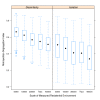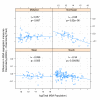Do measures matter? Comparing surface-density-derived and census-tract-derived measures of racial residential segregation
- PMID: 20540797
- PMCID: PMC2898812
- DOI: 10.1186/1476-072X-9-29
Do measures matter? Comparing surface-density-derived and census-tract-derived measures of racial residential segregation
Abstract
Background: Racial residential segregation is hypothesized to affect population health by systematically patterning health-relevant exposures and opportunities according to individuals' race or income. Growing interest into the association between residential segregation and health disparities demands more rigorous appraisal of commonly used measures of segregation. Most current studies rely on census tracts as approximations of the local residential environment when calculating segregation indices of either neighborhoods or metropolitan areas. Because census tracts are arbitrary in size and shape, reliance on this geographic scale limits understanding of place-health associations. More flexible, explicitly spatial derivations of traditional segregation indices have been proposed but have not been compared with tract-derived measures in the context of health disparities studies common to social epidemiology, health demography, or medical geography. We compared segregation measured with tract-derived as well as GIS surface-density-derived indices. Measures were compared by region and population size, and segregation measures were linked to birth record to estimate the difference in association between segregation and very preterm birth. Separate analyses focus on metropolitan segregation and on neighborhood segregation.
Results: Across 231 metropolitan areas, tract-derived and surface-density-derived segregation measures are highly correlated. However overall correlation obscures important differences by region and metropolitan size. In general the discrepancy between measure types is greatest for small metropolitan areas, declining with increasing population size. Discrepancies in measures are greatest in the South, and smallest in Western metropolitan areas. Choice of segregation index changed the magnitude of the measured association between segregation and very preterm birth. For example among black women, the risk ratio for very preterm birth in metropolitan areas changed from 2.12 to 1.68 for the effect of high versus low segregation when using surface-density-derived versus tract-derived segregation indices. Variation in effect size was smaller but still present in analyses of neighborhood racial composition and very preterm birth in Atlanta neighborhoods.
Conclusion: Census tract-derived measures of segregation are highly correlated with recently introduced spatial segregation measures, but the residual differences among measures are not uniform for all areas. Use of surface-density-derived measures provides researchers with tools to further explore the spatial relationships between segregation and health disparities.
Figures







References
-
- Myrdal G. An American Dilemma: The Negro Problem and Modern Democracy. New York: Harper and Brothers; 1944.
-
- Massey DS, Denton NA. American apartheid : segregation and the making of the underclass. Cambridge, Mass.: Harvard University Press; 1993.
-
- Cutler DM, Glaeser EL, Vigdor JL. The rise and decline of the American ghetto. Journal of Political Economy. 1997;107(3):455–506. doi: 10.1086/250069. - DOI
-
- DuBois WEB. The Philadelphia Negro. Philadelphia: University of Pennsylvania Press; 1899.
-
- Yankauer A. The relationship of fetal and infant mortality to residential segregation: An inquiry into social epidemiology. American Sociological Review. 1950;15(5):644–648. doi: 10.2307/2086918. - DOI
Publication types
MeSH terms
Grants and funding
LinkOut - more resources
Full Text Sources

